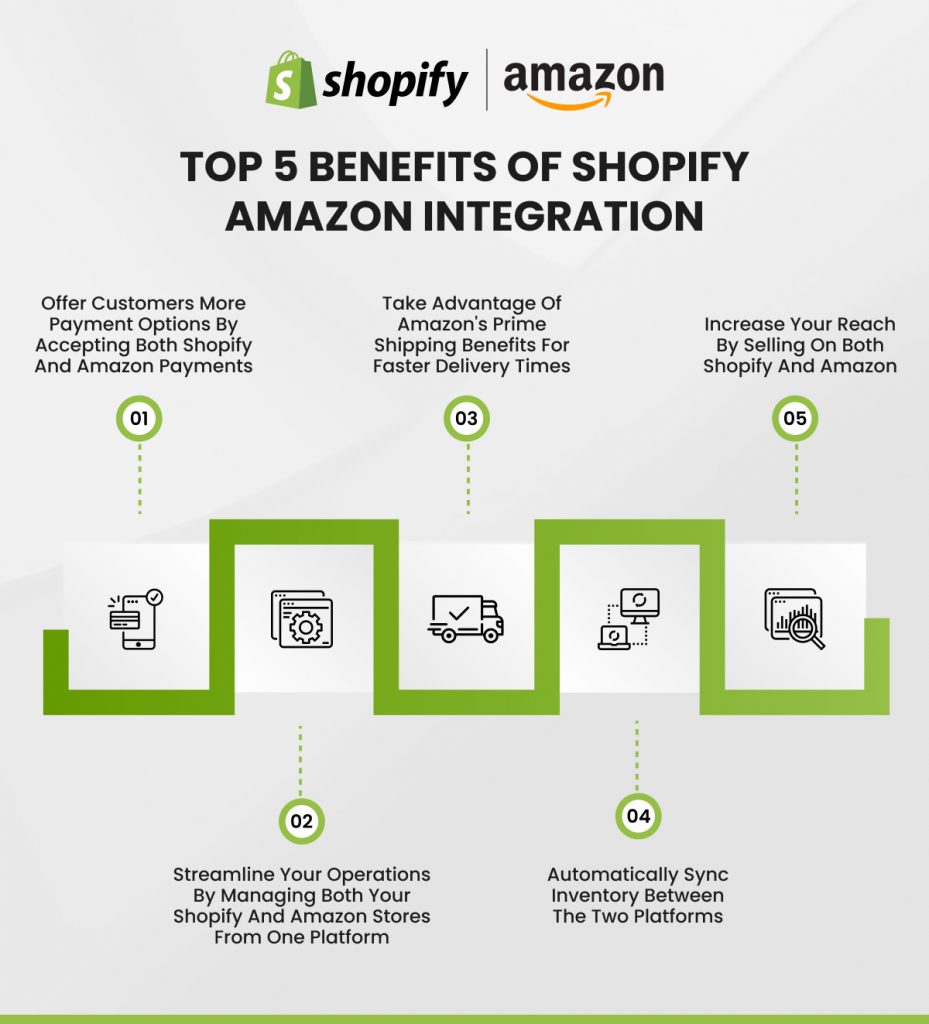mehroz@eqappo.com
Shopify Store Integration with Amazon: A Comprehensive Guide
In today’s competitive e-commerce landscape, businesses must leverage multiple platforms to maximize reach, sales, and brand visibility. One of the most powerful combinations available to online sellers is integrating a Shopify store with Amazon. By syncing these two giants of e-commerce, sellers can efficiently manage inventory, expand their customer base, and streamline operations. In this article, we will explore the benefits of Shopify-Amazon integration, the steps to integrate your store, and some tips for optimizing this powerful e-commerce duo. Let us dive into further details.

Why Integrate Your Shopify Store with Amazon?
- Expanded Reach and Market Penetration
Amazon is one of the world’s largest online marketplaces, with millions of active buyers. By integrating your Shopify store with Amazon, you tap into this vast customer base, increasing your chances of making sales. This integration allows you to showcase your products to a broader audience who may not visit your Shopify store directly.
- Centralized Inventory Management
Managing inventory across multiple platforms can be a logistical challenge. Integration simplifies this process by allowing you to sync your inventory between Shopify and Amazon. When a product sells on Amazon, the inventory is automatically updated in Shopify, reducing the risk of overselling and keeping your stock levels accurate.
- Increased Sales Channels
Shopify integration with Amazon enables you to sell on multiple channels without the need to duplicate your efforts. Your Shopify store remains your primary hub, but with the integration, you can list your products on Amazon and manage orders from one centralized dashboard. This multi-channel approach can lead to increased sales and brand exposure.
- Streamlined Order Fulfillment
The integration allows you to use Amazon’s fulfillment services, such as Fulfillment by Amazon (FBA). FBA handles storage, packaging, and shipping, which can save you time and resources. You can manage both FBA and Shopify orders from a single platform, ensuring a seamless fulfillment process.
- Improved Customer Trust
Amazon is a trusted name in e-commerce, and listing your products on their platform can enhance your brand’s credibility. Many customers feel more comfortable purchasing from Amazon due to its established reputation, which can lead to higher conversion rates for your products.

How to Integrate Shopify with Amazon
- Set Up an Amazon Seller Account
Before you can integrate Shopify with Amazon, you need an active Amazon Seller account. If you don’t have one, visit Amazon Seller Central and sign up. Choose the appropriate plan (Individual or Professional) based on your business needs.
- Install the Amazon Sales Channel on Shopify
Shopify offers a built-in Amazon integration through its Amazon Sales Channel app. To install it, log in to your Shopify admin, go to the “Sales Channels” section, and click on the “+” button to add a new sales channel. Select “Amazon” from the list and follow the prompts to connect your Amazon Seller account.
- Link Your Shopify Products to Amazon Listings
Once the Amazon Sales Channel is installed, you can link your Shopify products to existing Amazon listings or create new listings directly from Shopify. You can choose to list all or specific products, depending on your inventory and sales strategy.
- Configure Pricing and Inventory Settings
After linking your products, configure your pricing rules and inventory settings. You can set different prices for Amazon and Shopify, account for Amazon fees, and choose how inventory is managed between the platforms. Ensure that your inventory levels are accurately synced to avoid stock discrepancies.
- Manage Orders and Fulfillment
With the integration complete, you can now manage your Amazon orders directly from your Shopify dashboard. If you use Fulfillment by Amazon (FBA), you can route orders to Amazon for fulfillment. For Shopify-fulfilled orders, process them as you normally would, but with the added advantage of managing everything from one place.

Tips for Optimizing Your Shopify-Amazon Integration
- Optimize Product Listings
Ensure your product listings are optimized for both Shopify and Amazon. Use relevant keywords, high-quality images, and compelling descriptions. Remember that Amazon’s SEO is different from Shopify’s, so tailor your listings to fit both platforms.

- Monitor Performance Metrics

Keep track of your sales performance on both Shopify and Amazon. Use analytics tools to monitor traffic, conversion rates, and customer behavior. This data can help you make informed decisions on pricing, inventory management, and marketing strategies.
- Stay Compliant with Amazon Policies
Amazon has strict policies and guidelines for sellers. Make sure you stay compliant with these rules to avoid penalties or account suspension. Regularly review Amazon’s terms of service to ensure your listings meet their standards.

- Leverage Amazon Advertising

Consider using Amazon’s advertising tools, such as Sponsored Products or Sponsored Brands, to boost visibility and drive more sales. Combined with Shopify’s marketing capabilities, you can create a robust advertising strategy that covers both platforms.
- Provide Excellent Customer Service
Customer satisfaction is key to success on both Shopify and Amazon. Ensure that you respond promptly to customer inquiries, address issues effectively, and maintain a high level of service to build a positive reputation.

Conclusion
Another post on the topic: All About Cialis: What You Need to Know for Effective Use
Integrating your Shopify store with Amazon is a powerful strategy that can significantly boost your e-commerce business. By expanding your market reach, simplifying inventory management, and streamlining order fulfillment, you can achieve greater efficiency and profitability. However, success requires careful planning, ongoing optimization, and a commitment to providing top-notch customer service. With the right approach, Shopify and Amazon can become a winning combination for your online business. At Eqappo we offer a complete service related to integration of Amazon with Shopify Store.



